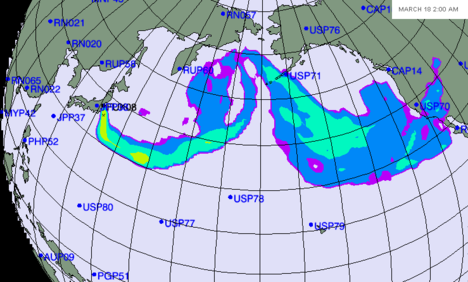Five Years of Forgetting: The Fukushima Disaster and Nuclear Amnesia
“People’s understanding of disasters will continue to be constructed by media. How media members frame the presence of risk and the nature of disasters matters.” – Celine Marie Pascale, American University, Mar 10, 2015.
Fearing radiation; terrified by the nuclear option. Perfectly sensible instincts that never seem to convince establishments and those who have long ceased to loathe nuclear power and its various dangerous by-products. Each nuclear disaster, such as the meltdowns at the Fukushima Daiichi plants five years ago, come with its treasure of apologetics and justifications. The reason is always the same: nuclear energy is safe and we cannot really do without it.
To that end, the emergence of “radiophobia” is a designation that dismisses as much as it supposedly diagnoses. It pokes fun at those ninnies who think that they are about to perish because of the effects of nuclear catastrophe and radiation contamination. Risk, according to this philosophy of concerted denial, is always exaggerated.
Shunichi Yamashita, a proclaimed expert on the effects of radioactivity, was invited by the Fukushima prefecture in the aftermath of the meltdown to reassure rather than investigate. “The effects of radiation,” he claimed, “do not come to people who are happy and laughing, they come to people who are weak-minded.”[1]
This Dr. Strangelove dismissiveness is as much an advertisement for the virtues of doom as it is about the brutal consequences, real and imaginary, of radiation poisoning. Radiation is the invisible killer that stalks the earth, but for many, it is hardly worth a thought. For one, it suggests a simple calculation in environments that are not, supposedly, that dangerous. “With low radiation doses,” argued this doctor of nuclear apologetics, “the people have to decide for themselves whether to stay or to leave.”

Despite this bubbling confidence on the part of his colleagues, Japanese American physicist Michio Kaku had little time for such views as Yamashita’s. In an interview soon after the meltdown, Kaku claimed that,
“The slightest disturbance could set off a full-scale meltdown at three nuclear power stations, far beyond what we saw at Chernobyl.”[2]
Smile with upbeat confidence, and the problem goes away. If people are depressed before radiation, suggests Yamashita, they will succumb as the negative dramatists they are. “Stress is not good at all for people who are subjected to radiation.” Then again, stress could hardly be deemed good for anybody in particular, irrespective of radiation.
Such fabulously misguided nonsense is central to the amnesiac context of Fukushima. Makiko Segawa put it rather poignantly in his contribution in the Asia-Pacific Journal: initial enthusiastic snaps and coverage by the press corps, an insatiable lust for disaster imagery, quietened in due course. Writing a year after the disaster, Segawa noted how “the journalists have packed up and gone and by accident of design Japan’s government seems to be mobilizing its agenda, aware that it is under less scrutiny.”[3]
Robert Jacobs similar notes that Fukushima conforms to that litany of disasters that has afflicted the human experience, a matter of rejection and experience rather than learning and adapting. “Fukushima is taking its place alongside the many forgotten nuclear disasters of the last 70 years.”[4]
Sociologist Celine Marie Pascale of the American University, on scouring some 2,100 news stories from four media outlets (The New York Times, Washington Post, The Huffington Post and Politico) came to the conclusion that a strategy of minimisation was underway.[5] The implications of such an event had to be downplayed, de-emphasising the risk of massive contamination and environmental disaster. A mere 6 per cent of the articles examined the health implications of the event.
“We see articles in prestigious news outlets claiming that radioactivity from cosmic rays and rocks is more dangerous than the radiation emanating from the collapsing Fukushima Daiichi nuclear plant.”[6]
A necessary process of mendacity has to come into play. The Tokyo Electric Power Plant (TEPCO), Japan’s largest power company and owner of the affected power plants, initially denied the existence of meltdowns when it knew three had taken place. It was a process of deception that continued for three months after the event, a situation made even more absurd for the fact that hundreds of thousands were evacuated in the vicinity. It is a disaster episode that keeps on giving.
Even in March 2015, their reassurances seemed less than comforting. Chief Decommissioning Officer Naohiro Masuda would claim rather blandly that, “Even if some contaminated water remains, I feel that we can reduce a substantial amount of risk.”[7]
The nuclear genie is a creature that encourages the lie in planning establishments. There are lies about safety; there are lies about legacies. As Jacobs suggests, the Disneyfication of disaster sites affected by the nuclear or atomic scourge is all too real. The Manhattan Project that led to the development of the atomic weapons used on Hiroshima and Nagasaki became “Disney theme parks of American exceptionalism”. The quest for the nuclear option in both the military and energy contexts saw massive environmental degradation.
Dr. Binoy Kampmark was a Commonwealth Scholar at Selwyn College, Cambridge. He lectures at RMIT University, Melbourne. Email: [email protected]
Notes:
- http://www.spiegel.de/
international/world/studying- the-fukushima-aftermath- people-are-suffering-from- radiophobia-a-780810.html - http://www.democracynow.org/
2011/4/13/expert_despite_ japanese_govt_claims_of - http://apjjf.org/2012/10/19/
Makiko-Segawa/3752/article. html - http://apjjf.org/2016/05/
Jacobs.html - https://isaconf.confex.com/
isaconf/wc2014/webprogram/ Paper39469.html - http://www.american.edu/media/
news/20150310-Fukushima.cfm - http://www.tepco.co.jp/en/
press/corp-com/release/2015/ 1248751_6844.html


